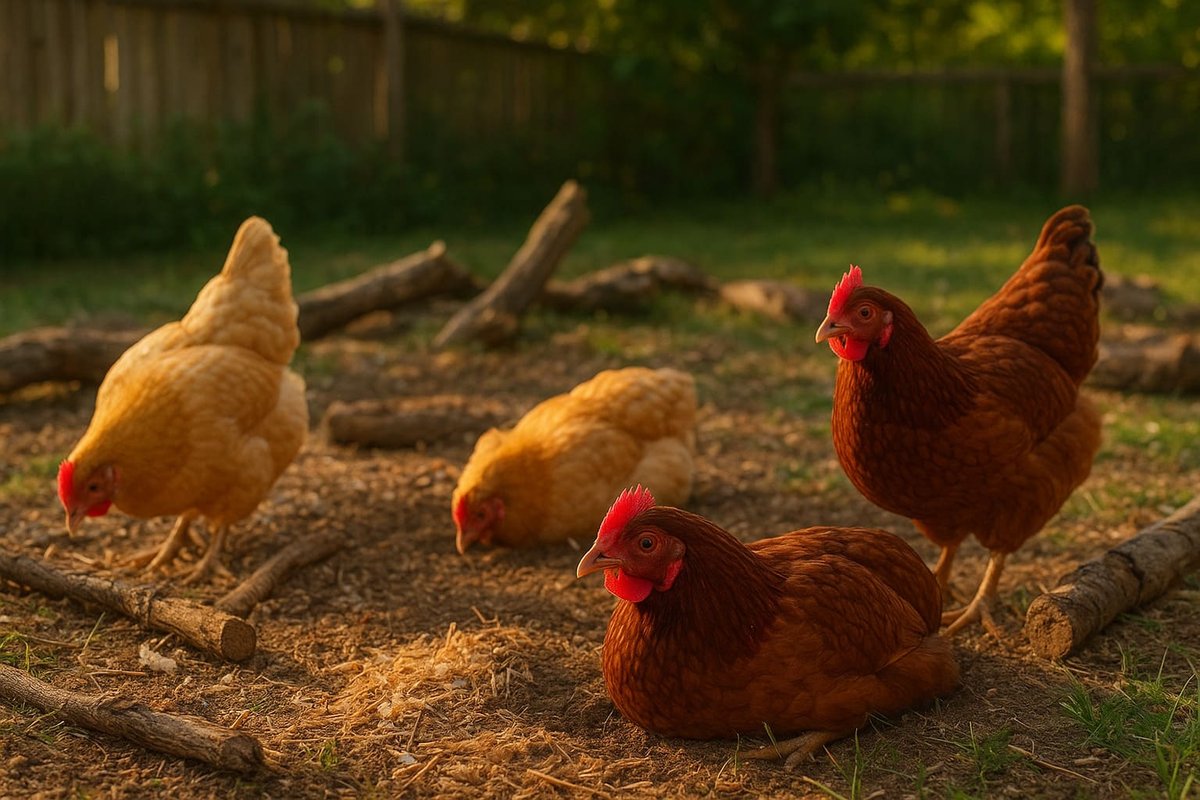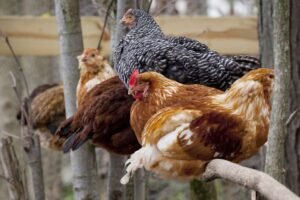Ever watched your chickens scratch at the dirt and wondered what’s really going on? That isn’t just random digging; it’s a deep, natural instinct. Understanding how to encourage natural foraging behavior for happier, healthier chickens is one of the most important things you can do for your flock. After years of raising my own backyard chickens, I’ve learned it’s the key to unlocking better health, reducing stress, and building a stronger bond with your birds. This guide will walk you through everything from the science behind foraging to dozens of easy and affordable DIY chicken enrichment ideas you can try today.
Why Natural Foraging Behavior Matters for Chicken Health and Happiness
Foraging is more than just a way for chickens to find food. It’s a collection of species-specific behaviors—like scratching, pecking, and exploring—that are hardwired into their DNA. This drive to forage is a core part of their behavioral repertoire, a set of instincts passed down from their wild ancestors, the Red Junglefowl. When a chicken forages, it’s not just eating; it’s exercising its body and mind. Encouraging this natural foraging instinct is crucial for their overall chicken welfare. According to poultry welfare research, allowing chickens to perform these actions reduces stress hormones and prevents problem behaviors like feather pecking (PMC Study on Laying Hens). So, do chickens need enrichment? Yes, absolutely. Environmental enrichment is the practice of providing stimuli that encourage these natural behaviors, leading to a happier, healthier flock (The Open Sanctuary Project).
How to Tell If Your Chickens Are Happy and Healthy
One of the best parts of raising chickens is learning to read their behavior. A happy flock has clear signs that tell you you’re doing a great job.
Physical Signs of Happy Chickens
Happy, healthy chickens have bright, clear eyes and clean nostrils. Their feathers will be smooth, glossy, and full—not ragged or broken. They are active and alert, regularly moving around their coop and run. You’ll also see them consistently dust bathing, which is a natural behavior for cleaning feathers and deterring parasites. For laying hens, consistent and high-quality egg production is another strong indicator of good health and low stress, which can be supported with the right chicken treats.
Behavioral Indicators
The clearest behavioral sign of a happy chicken is seeing them engage in natural foraging and scratching throughout the day. They will eagerly explore their environment, peck at interesting objects, and scratch through litter. At night, a content flock will naturally go inside to roost on their perches and roosting bars. Within the flock, you’ll see calm, predictable social interactions rather than constant squabbling or aggression.
Signs Your Chickens Are Stressed
Knowing the signs of stress helps you address problems early. One of the most common signs is feather pecking, where chickens pluck feathers from themselves or their flock mates. Research shows that providing a stimulating, enriched environment is one of the most effective ways to reduce this harmful behavior (PMC Study on Laying Hens). Stressed chickens also show decreased activity, huddling in a corner instead of exploring. You might also notice a sudden drop in egg production or an increase in aggressive behavior. Addressing stress is key to how to make chickens less stressed, and enrichment is a primary solution.
What Chickens Need in Their Coop to Be Happy and Healthy
A great coop is more than just shelter; it’s a safe and engaging home base. Your coop design should support both physical health and behavioral needs.
Essential Coop Features
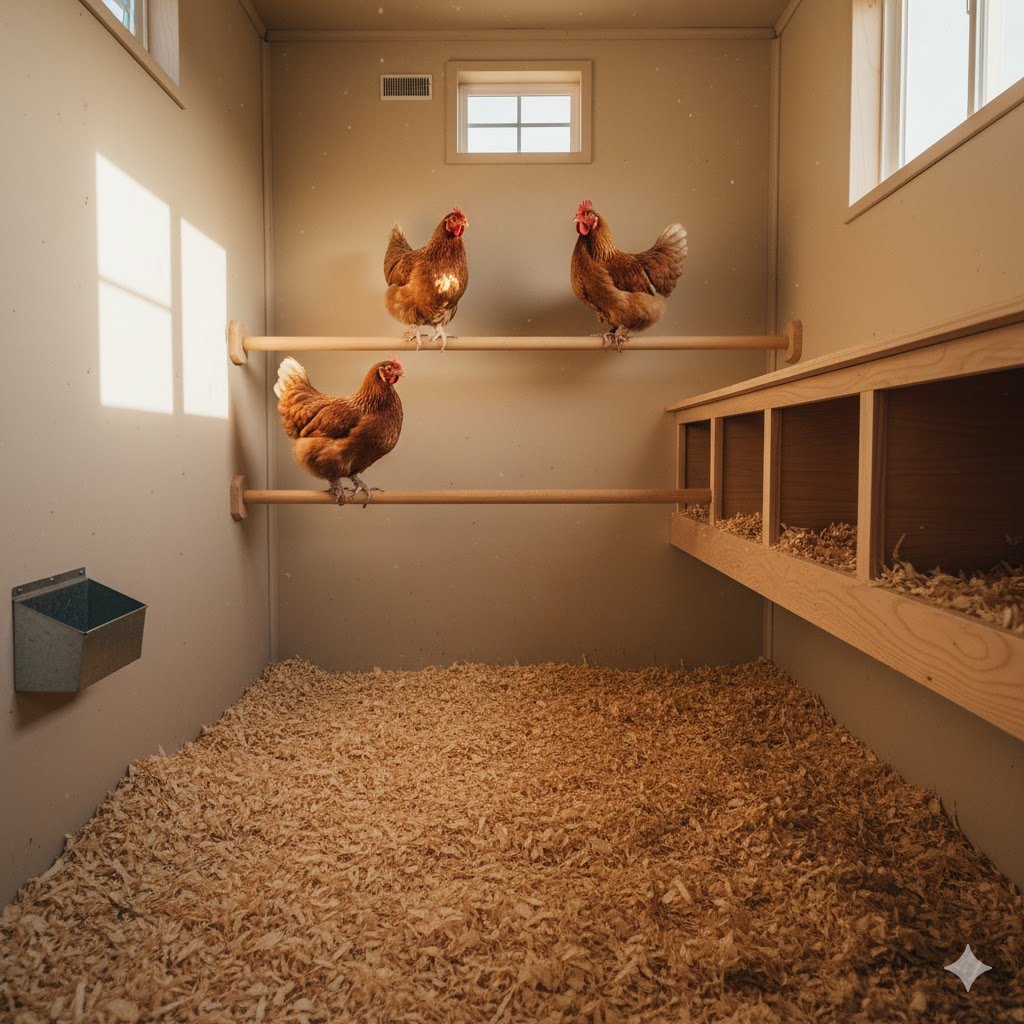
Every chicken coop needs a few non-negotiables for a happy flock.
- Proper Roosting Bars: Chickens have a natural instinct to roost off the ground at night. To answer the question, do chickens like to climb? Yes, they absolutely do, especially to feel safe while sleeping. Roosting bars should be about 2 to 4 inches wide with rounded edges and placed at least 2-4 feet off the ground. Studies confirm that access to perches is a high priority for hens and crucial for their welfare (PMC Study on Broiler Chickens).
- Adequate Space: Provide at least 4 square feet of coop space per bird for standard breeds to prevent overcrowding and stress.
- Ventilation: Good airflow is critical for preventing respiratory issues. Ensure there is ventilation high up in the coop that doesn’t create a direct draft on the roosting birds.
- Nest Boxes: Provide one clean, private nest box for every 4-5 laying hens.
Enrichment Essentials
Even within the coop, you can encourage natural behaviors.
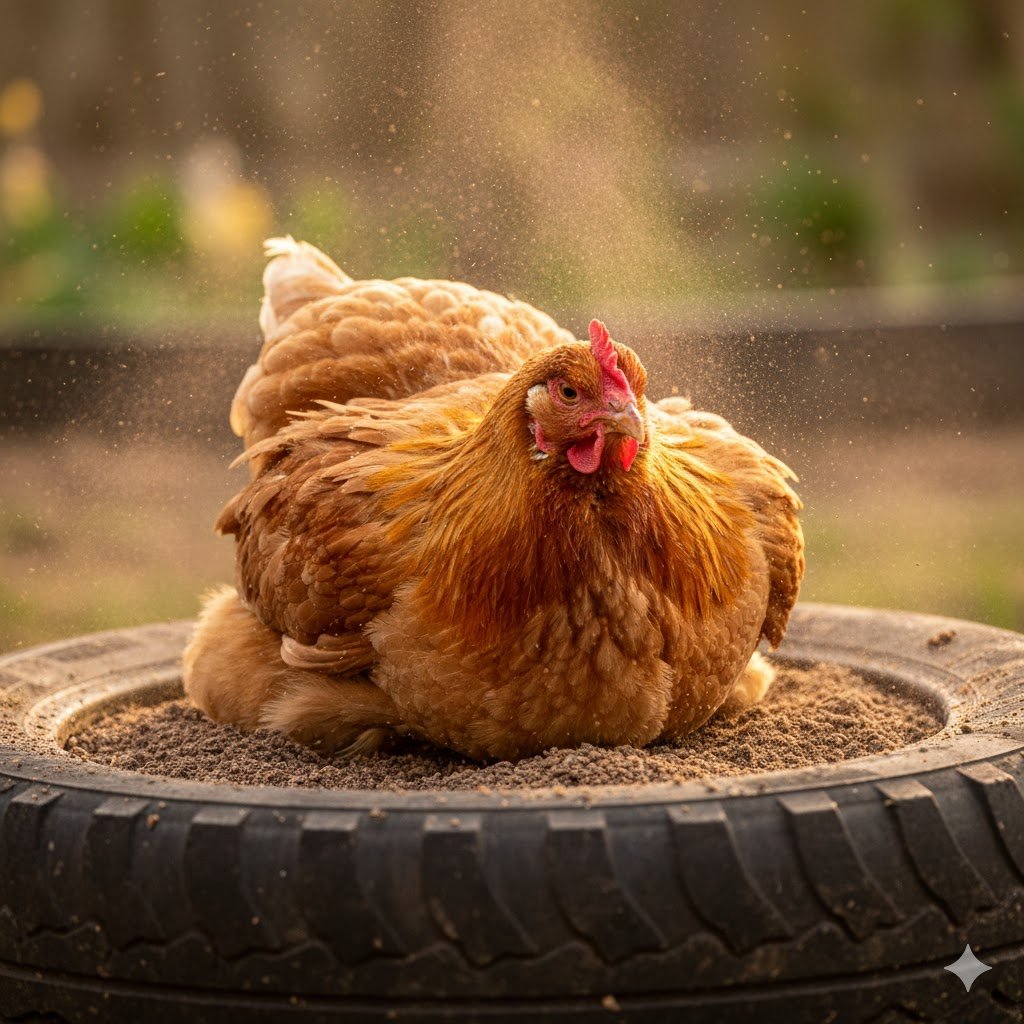
- Dust Bath Area: A dedicated dust bath area inside the coop or in a covered part of the run is essential. A shallow box or tire filled with a mix of sand, dry soil, and a little food-grade diatomaceous earth is perfect. A good dust bath needs 6-8 inches of depth for them to properly fluff and clean. This is a critical behavior, and providing a proper dust bath is considered an essential part of chicken welfare (IAABC Foundation Journal).
- Varied Perching Heights: Adding perches at different heights utilizes vertical space and allows chickens to choose their preferred spot, mimicking a natural environment.
- Visual Interest: Simple additions like a non-glass, shatterproof mirror or even bundles of safe herbs hanging from the ceiling can provide visual enrichment.
How to Encourage Natural Foraging Behavior in Your Flock
Now for the fun part: actively encouraging your chickens to do what they do best. It’s all about creating an environment that sparks their curiosity.
Creating a Foraging-Friendly Environment
- Provide Appropriate Litter: The “deep litter method” is fantastic for this. A thick layer (6-8 inches) of pine shavings, chopped straw, or other organic litter material gives them of substrate to scratch through.
- Scatter Feeding: Instead of just putting feed in a feeder, scatter a portion of their daily grains or scratch mix into the litter. This immediately triggers their scratching behavior and makes them work for their food.
- Add Natural Materials: Place interesting items like logs, large branches, or even a pile of autumn leaves in their run. They will love climbing on them and scratching for any bugs that might be hiding underneath.
Food-Based Foraging Enrichment
- Live Insects: Chickens are natural insectivores. Black soldier fly larvae (also called Calci-worms) are an excellent, protein-rich treat that you can sprinkle in their run to encourage pecking and searching.
- Treat Dispensers and Puzzle Feeders: You can buy or make treat dispensers that chickens have to peck or roll to release food. This is a great form of cognitive enrichment.
- Hanging Vegetable Treats: A simple head of cabbage or broccoli hung from a string just above head height will keep them entertained for hours. You can find a complete list of what chickens can eat from your kitchen in our comprehensive guide.
- Sprouted Seeds: Sprouting lentils, sunflower seeds, or wheat berries provides a nutritious and exciting treat that encourages natural pecking.
15+ DIY Chicken Enrichment Ideas for Natural Foraging
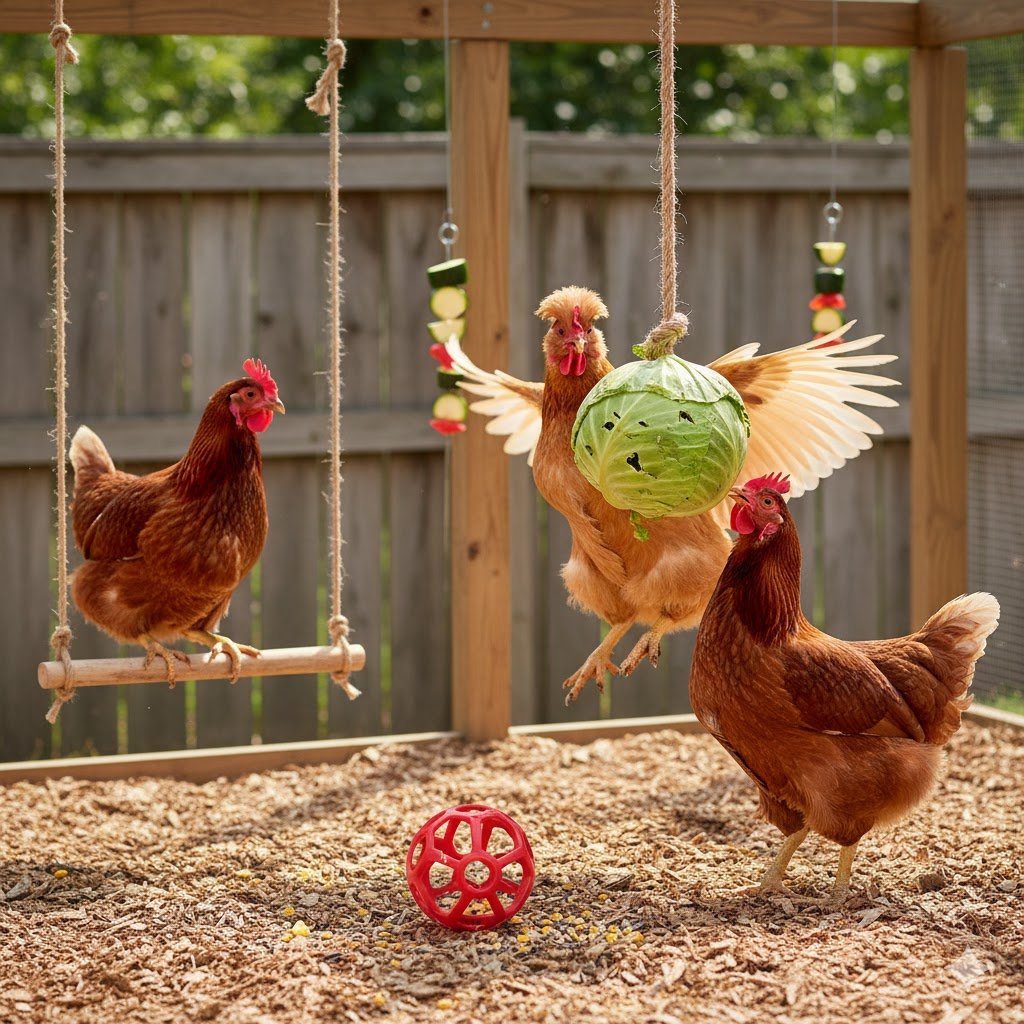
After testing 10+ DIY enrichment ideas with my backyard flock of Rhode Island Reds and Buff Orpingtons, these are the ones that have been the biggest hits and provided the most lasting engagement.
Environmental Enrichment Ideas
- A-Frame Structures: A simple A-frame made from untreated wood provides climbing structures and a place to perch or hide.
- Evergreen “Forest”: Place old Christmas trees or large, safe evergreen branches in the run. This is especially great in winter when the run is muddy or covered in snow, as it gives them a bit of green to interact with.
- Logs and Stumps: Different-sized logs and stumps create varied terrain and new perching opportunities.
- Dust Bath Stations: Create multiple dust bath spots. In my experience, even if you make a perfect one, they’ll still dig their own, but having a designated, dry spot is always a good idea.
- Chicken Tunnels: A simple dog agility tunnel or a DIY version made from wire fencing can provide a fun new way for your flock to explore their space. My flock was hesitant at first, but within a week of seeing me toss some scratch grains inside, they were happily running through it.
Chicken Enrichment Toys
- Chicken Swings: How to make a chicken swing? It’s easy! Just take a sturdy, natural branch about 2 feet long and hang it securely with rope so it’s about 1-2 feet off the ground. My Rhode Island Reds took a few days to get used to it, but now they love gently swinging on it.
- Chicken Xylophone: You can buy toy xylophones made for chickens. They will peck at the keys, creating sounds and providing auditory enrichment.
- Mirrors: A shatter-proof mirror securely fastened to a wall can provide hours of visual stimulation. When I first introduced one, my flock spent a good 20 minutes curiously pecking at their reflections.
- Treat Balls and Puzzle Toys: A simple plastic ball with holes drilled in it, filled with scratch grains, becomes a fun and rewarding toy.
- Hanging CDs: Old CDs or other reflective items strung together can create a mobile that catches the light and provides visual interest.
Food-Based Enrichment Activities
- Treat Kebabs: String chunks of fruits and vegetables like apples, melons, and zucchini onto a metal skewer and hang it in the run.
- Tether Treats: Tie a sturdy root vegetable like a turnip or sweet potato to a rope and hang it. The swinging motion makes it a fun challenge.
- DIY Suet Blocks: Make your own treat blocks using coconut oil, scratch grains, seeds, and mealworms. Pour into a mold, freeze, and then place in a suet cage. In winter, frozen treat blocks work better than hanging fresh vegetables, which can freeze solid and be hard for them to peck.
- Scattered Mealworms in Litter: This is a classic for a reason. Scattering a handful of dried mealworms into fresh litter is one of the fastest ways to trigger excited foraging activities. I’ve found it’s also the single fastest way to halt budding flock tensions.
- Sprouting Stations: Create a shallow frame with hardware cloth over the top. Plant seeds underneath, and as they sprout, chickens can peck at the greens through the wire without destroying the plants completely.
What to Put in Your Chicken Run for Entertainment
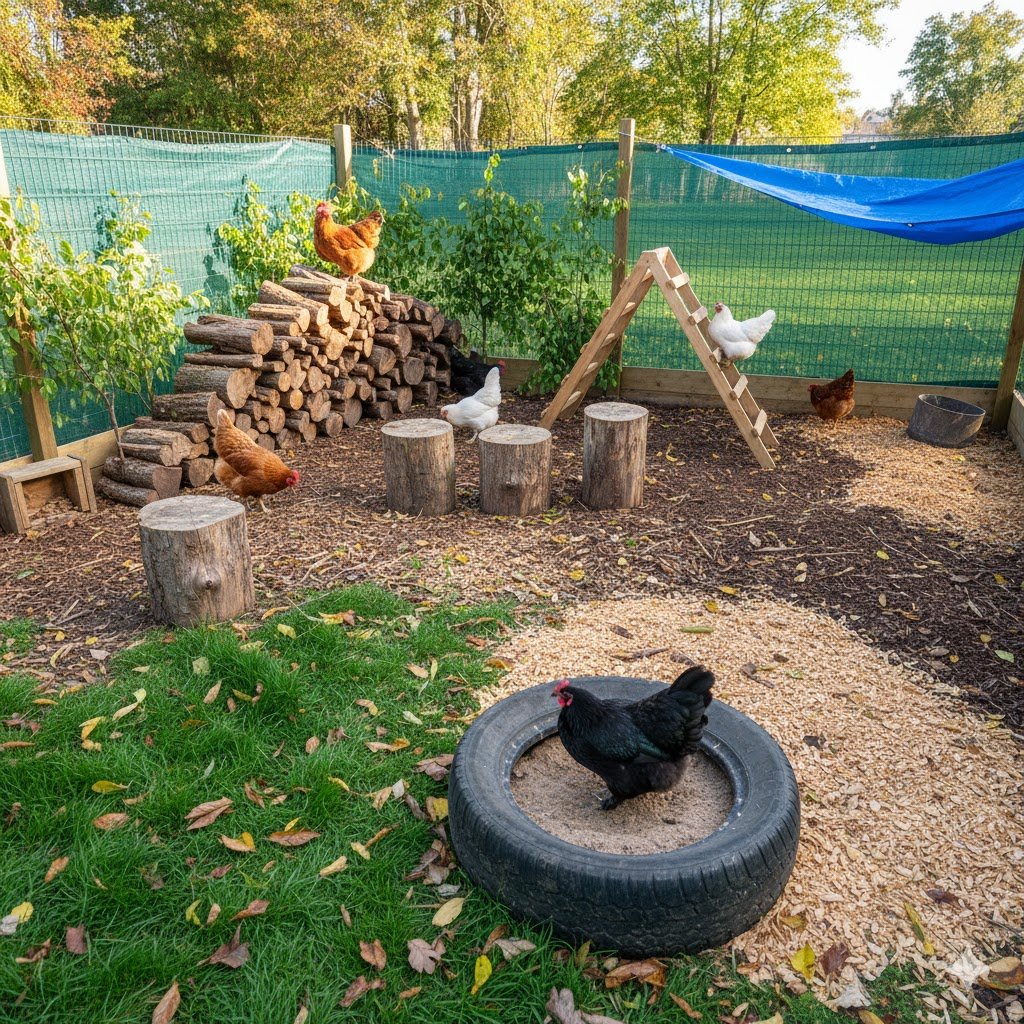
Your chicken run is where your flock spends most of its day, so making it an engaging outdoor space is key. Deciding between a dedicated chicken run vs. free-range setup depends on your space and predator load, but you can enrich any run.
- Perching Trees and Branches: A sturdy, multi-branched log or a chicken-safe small tree can serve as a natural jungle gym.
- Varied Ground Substrates: Don’t just have dirt. Add areas with sand, wood chips, or straw to provide different textures for them to scratch in.
- Protected Foraging Areas: A simple frame covered in wire mesh can protect a patch of clover or chicken-safe herbs, allowing them to eat the greens without digging up the roots.
- Play Structures: Simple ramps, small platforms, and obstacles encourage movement and exploration.
- Shade and Shelter: Provide shady spots using tarps, shrubs, or structures to ensure they have a comfortable place to rest.
Chicken Yard Ideas for Maximum Enrichment
If you have a larger chicken yard, you have even more opportunities for enrichment.
- Rotational Foraging Areas: Use temporary fencing to divide your yard into several paddocks. Let your flock forage in one area for a week or two, then move them to the next. This gives the vegetation time to recover and keeps things new and exciting for the chickens.
- Planted Zones: Plant chicken-safe herbs like lavender, mint, and oregano. They provide sensory enrichment and are healthy for the flock.
- Compost Pile Access: Supervised access to a compost pile is a chicken paradise. It’s filled with bugs, worms, and vegetable scraps for them to discover.
- Natural Bug Habitats: A simple pile of logs or rocks will attract insects, creating a self-sustaining source of foraging entertainment.
How to Raise Chickens to Love You: Building Trust Through Enrichment
Wondering how to raise chickens to love you? The answer is trust, and enrichment time is the perfect opportunity to build it.
- Hand-Feeding: When you introduce a new enrichment item, offer some of the treats by hand. This teaches them to associate you with positive, rewarding experiences.
- Positive Reinforcement: Use a specific call when you bring treats or enrichment. They will quickly learn to come running when they hear it.
- Consistent, Gentle Interaction: Spend time just sitting with your flock while they explore their environment. Your calm presence will help them see you as a safe part of their world. Trust me, your chickens will thank you for it.
Troubleshooting Common Foraging and Enrichment Challenges
- What if chickens ignore enrichment? Don’t be discouraged. Sometimes it takes a few days for them to investigate something new. For example, my chickens completely ignored a brand new log for three days. I scattered some sunflower seeds on it, and suddenly it became the most interesting thing in the run. Patience and a little bribery go a long way.
- Preventing Resource Guarding: If you notice one chicken hoarding a toy or treat, provide multiple enrichment stations. Spreading enrichment out ensures everyone gets a chance.
- Budget-Friendly Options: Many of the best ideas are free! Use logs from your yard, hang vegetables from your kitchen, and use old (but safe) items from around your home. An old tire filled with sand makes a perfect dust bath for almost no cost.
- Safety Considerations: Be transparent about risks. Always prioritize safety when introducing new items. Use only untreated wood for perches and structures. Avoid thin strings or nets that could cause entanglement; opt for thick, sturdy ropes for swings. Ensure any toys are durable and can’t be broken apart and ingested. It’s always a good idea to supervise your flock with a new enrichment item for the first time.
- Providing Realistic Expectations: It’s important to be honest about results. Enrichment is a powerful tool for improving chicken welfare, but it won’t solve underlying health issues or severe, ingrained aggression. Also, not every chicken will like every toy. I’ve found that my Buff Orpingtons completely ignore things that my Rhode Island Reds love. The goal is to offer variety and discover what works for your specific flock, not to force them to play with something they don’t enjoy.
Frequently Asked Questions
Do chickens really need enrichment?
Yes, chickens absolutely need enrichment. Providing enrichment allows them to perform their natural behaviors, which is essential for reducing stress and promoting their physical and behavioral health.
Do chickens like toys?
Yes, chickens can enjoy toys, especially those that involve food or mimic natural behaviors. Puzzle feeders, treat balls, and even simple things like a hanging cabbage are all forms of toys that chickens enjoy.
Do chickens like to climb?
Yes, chickens have a strong natural instinct to climb to roost in high, safe places at night. Providing perches, ramps, and log piles satisfies this important behavioral need.
How often should I change enrichment items?
It’s a good idea to rotate enrichment items every week or two. This keeps things new and interesting and prevents your flock from getting bored with the same old things.
Can too much enrichment stress chickens?
While unlikely, a sudden, overwhelming change to their environment could be stressful. Introduce new items one at a time and give your flock a few days to get used to each new addition.
Conclusion
Encouraging natural foraging is about more than just giving your chickens something to do. It’s about honoring their instincts and providing them with a life where they can thrive, not just survive. By incorporating even just two or three of these chicken enrichment ideas, you will see a noticeable difference in your flock’s activity levels and overall happiness. From my own experience, the effort is more than worth it. There’s nothing more rewarding than watching a flock confidently and happily exploring the enriching world you’ve created for them.

Oladepo Babatunde is the founder of ChickenStarter.com. He is a backyard chicken keeper and educator who specializes in helping beginners raise healthy flocks, particularly in warm climates. His expertise comes from years of hands-on experience building coops, treating common chicken ailments, and solving flock management issues. His own happy hens are a testament to his methods, laying 25-30 eggs weekly.
